Dungeon Map Maker Release
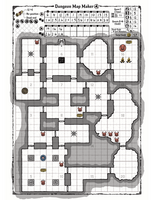
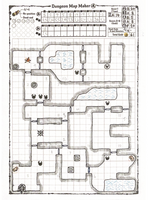

Introduction
On September 2nd, version 1 of Dungeon Map Maker was released.
Today, the files were updated to correct some minor mistakes in the rulebook. If you had already printed the rulebook off before today, there is no need to print off the current rulebook as the changes are mostly all minor typographical improvements.
However, with a bit more free time now, I thought today was a good time to talk about the game!
Background
Dungeon Map Maker was conceived over a year ago, with the idea of creating a companion game for Fantasy Map Maker. I liked the idea that players could play both games for enjoyment, with the resultant maps being able to be used for other purposes beyond the game, such as creating settings for D&D campaigns.
There are already a bunch of great games that focus on map creation, such as Cartograph and Ex Umbra. While these games focus more on free-form tabletop experiences, the goal of both Fantasy Map Maker and Dungeon Map Maker is to offer more of a "board game experience" with defined scoring.
There are also similar board games, such as Cartographers and Castles of Mad King Ludwig, which offer satisfying spatial puzzles, yet don't focus as much on the idea of creating a map.
Of course, there is some dissonance between creativity and the idea of winning or losing a game. Players looking for a map-making activity may not enjoy this potential disconnect. On the other hand - and what I get out of the game personally - is the sense that you can enjoy the puzzle of trying to earn points as you arrange your map, but then you end up with a plausible map at the end of the game!
Fantasy vs Dungeon
In Fantasy Map Maker, the player uses one game sheet to drive the entire gameplay, with 5 additional cards that determine how their map scores.
The "Feature Wheel" section allows you to see what features you still have access to in the game. An advantage of this system is that it minimises the paper needed to play the game (in previous iterations, the blank map area and feature wheel were on separate sheets). It also helps ensure that certain features will always be accessible no matter how unlucky your dice rolls are.
However, this is also a slight disadvantage as everything in the upper 2 fifths of the game sheet takes some of the focus away from the player's map.
With Dungeon Map Maker, it made more sense to put the room types on the scoring cards rather than the game sheet itself:
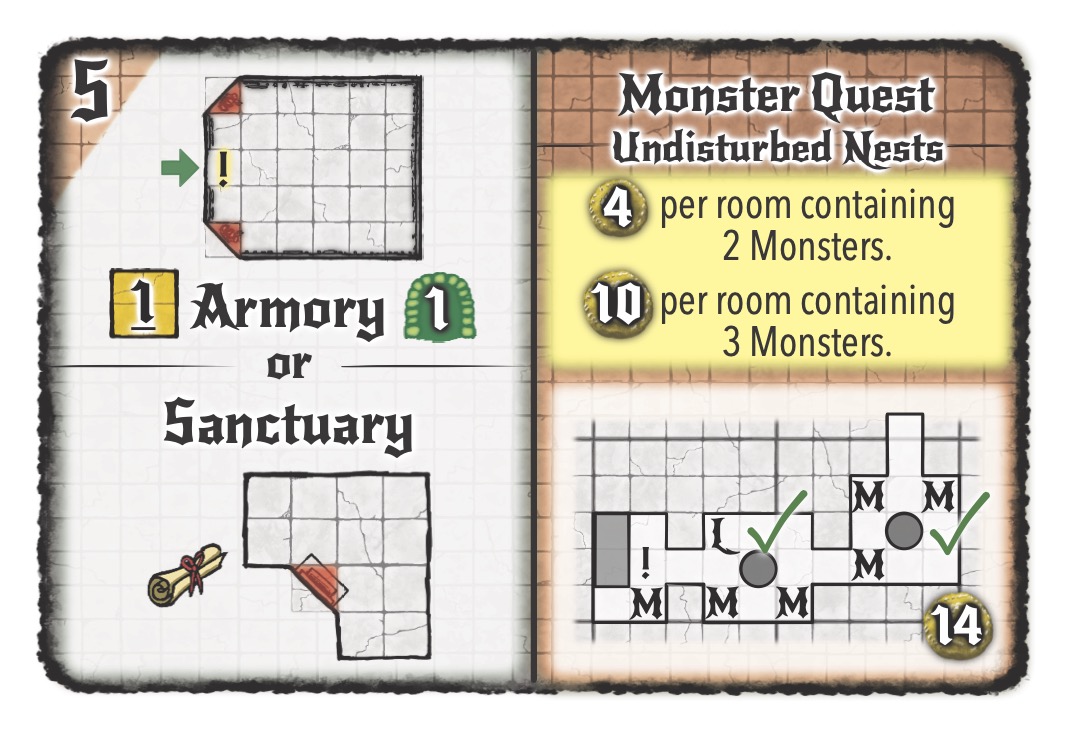
In turn, this allowed for more space in the game sheet for the dungeon map...
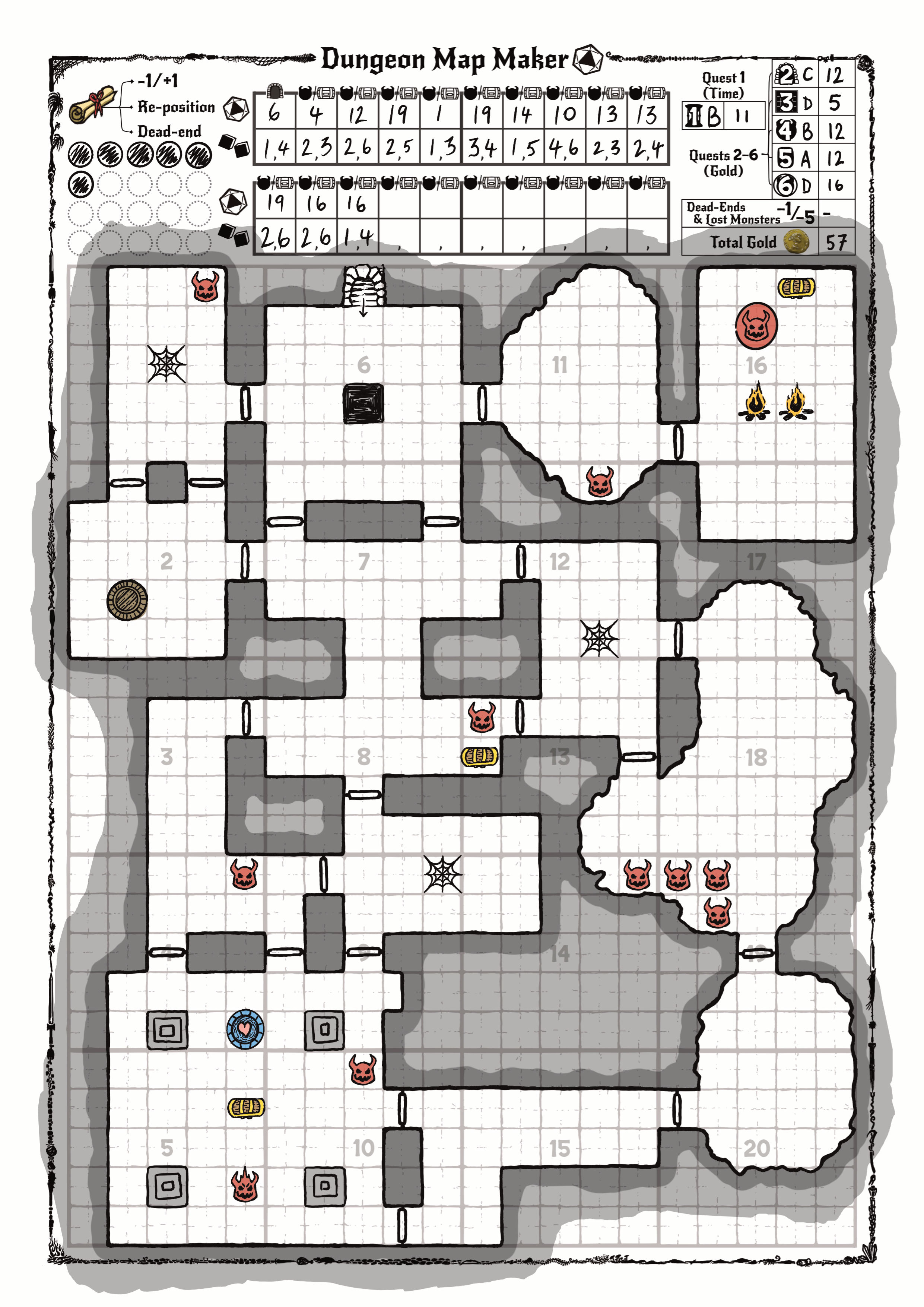
It is worth mentioning that a key difference is the "tension" of the two games.
In Dungeon Map Maker, the round-to-round rules are simpler:
- Roll 3 dice (D20 and 2D6)
- Draw a monster (or loot if possible) in the D20 area.
- Draw a room from x card and attach y openings to the room. (x = one of the 2D6 results; y = the other)
In my opinion, the tension of Dungeon Map Maker comes from 3 ongoing decisions:
- Having to account for the random locations monsters spawn in,
- Having to plan ahead for how different rooms may connect with one another,
- Having to sometimes choose a more difficult room option for the sake of earning gold/time (the game's points).
On the other hand, Fantasy Map Maker is a slightly more complex game due to the different rules for each of the features, but the tension in the game mostly boils down to one question: Can you place enough features to earn points before time runs out or your map becomes too crowded?
I think Fantasy Map Maker has one slight flaw when it comes to the maps it generates. Most of the time they look like fantasy maps. However, sometimes, if the player is pushing the rules to the limit, they can draw things that are within the rules, but would get them banned from most art schools.
Dungeon Map Maker on the other hand has the benefit of fitting in the tradition of drawing old school dungeon maps, which are often irregular by design. That said, it was still important to look at some great dungeon maps to gauge how many rooms should exist in the average dungeon and how big they should be. Studying maps by great RPG artists, such as Dyson Logos and Ways Unseen, helped in this regard.
There are, of course, restrictions that have to be in place for the game to work. For example, doorways between rooms need to uniformly take up one space, and there cannot be more than 6 openings/doorways off of one room. But these concessions don't stop the maps from turning out pretty dungeony!
I think proof of this is in the excellent maps created by the collaborators in the Dungeon Map Maker Map Pack.
Mapping Phase Updates
In addition to making a dungeon map in the game, there is also a second half of the game, in which the player can explore the dungeon they have created (more on this below).
Basically, Dungeon Map Maker is really two separate games: a mapping game and a dungeon crawler. Each card, then, had to have a "mapping" side and an "exploration" side.
To differentiate the two sides of the cards, the mapping sides were originally in landscape format. This was okay in the initial prototype when there were only 6 cards, but was ungainly as the base count of dungeon cards ballooned to 36. So, the cards were redesigned to make the following changes:
- To make the cards easier to shuffle together and find, all cards were reformatted into portrait format.
- To improve thematic immersion, the initials L and M to represent Loot and Monsters was replaced by simple icons.
- To reduce the amount of exceptions and accidental rule breaks, rooms that have restrictions to the number of openings (such as the Armory below) were removed.
- To keep the cards consistent, all rooms in the lower section offer a scroll upon placement.
- To make the rooms easier to draw, icons, such as barrels, hazards, and water were added to offer "reference points" (these also have gameplay effects in the Exploration Phase of the game).
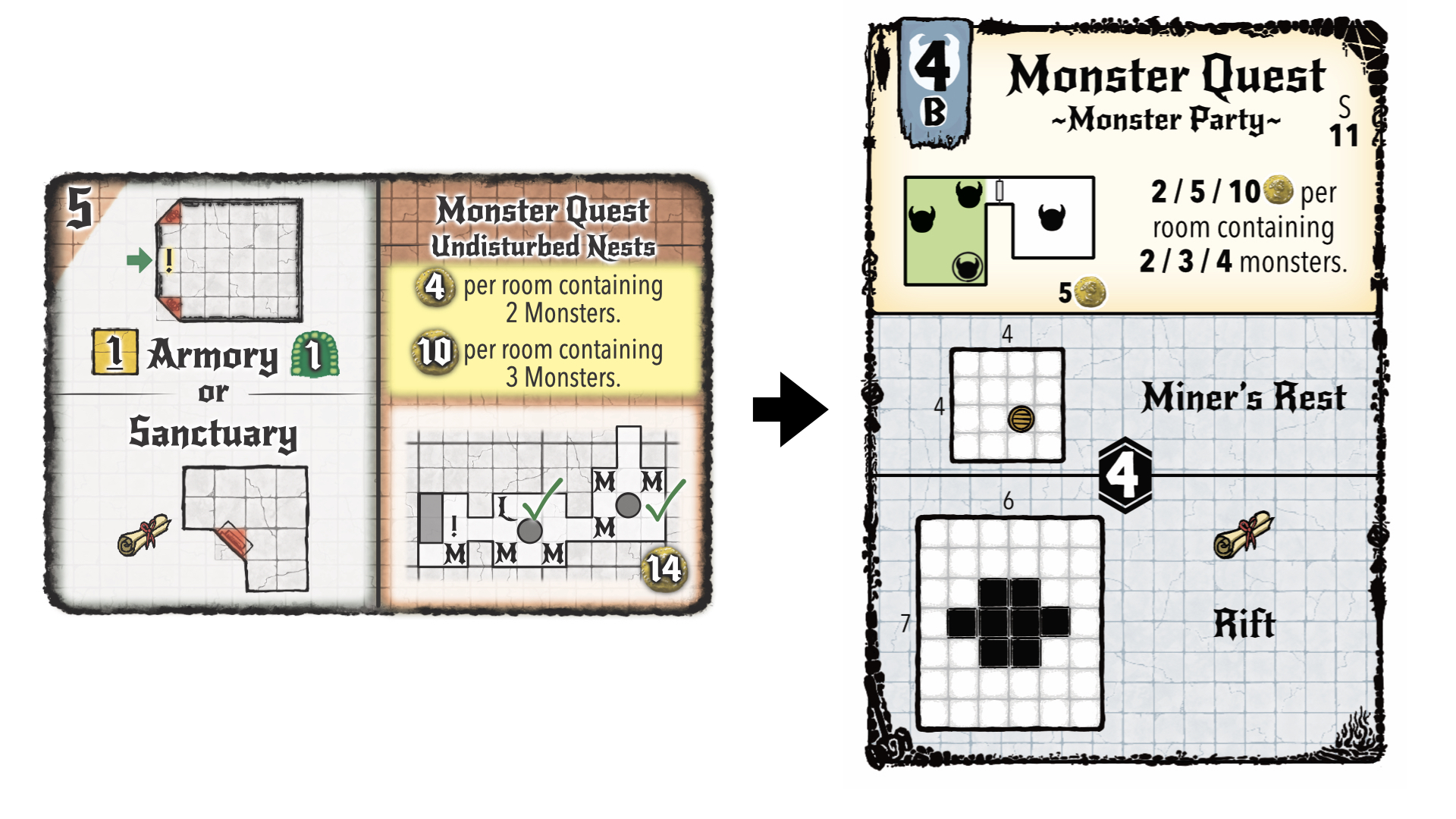
Meanwhile the following changes were made to the Dungeon Map game sheet:
- The area legend was removed to allow for a scoring section was added. Previously, the scoring was relegated to an extra mini sheet used in the exploration phase, but sometimes players just want to make the map without exploring it, so it made sense to add it to the map game sheet.
- To make the map easier to draw (and to save printer ink!), the grid was re-done to not be so dark.
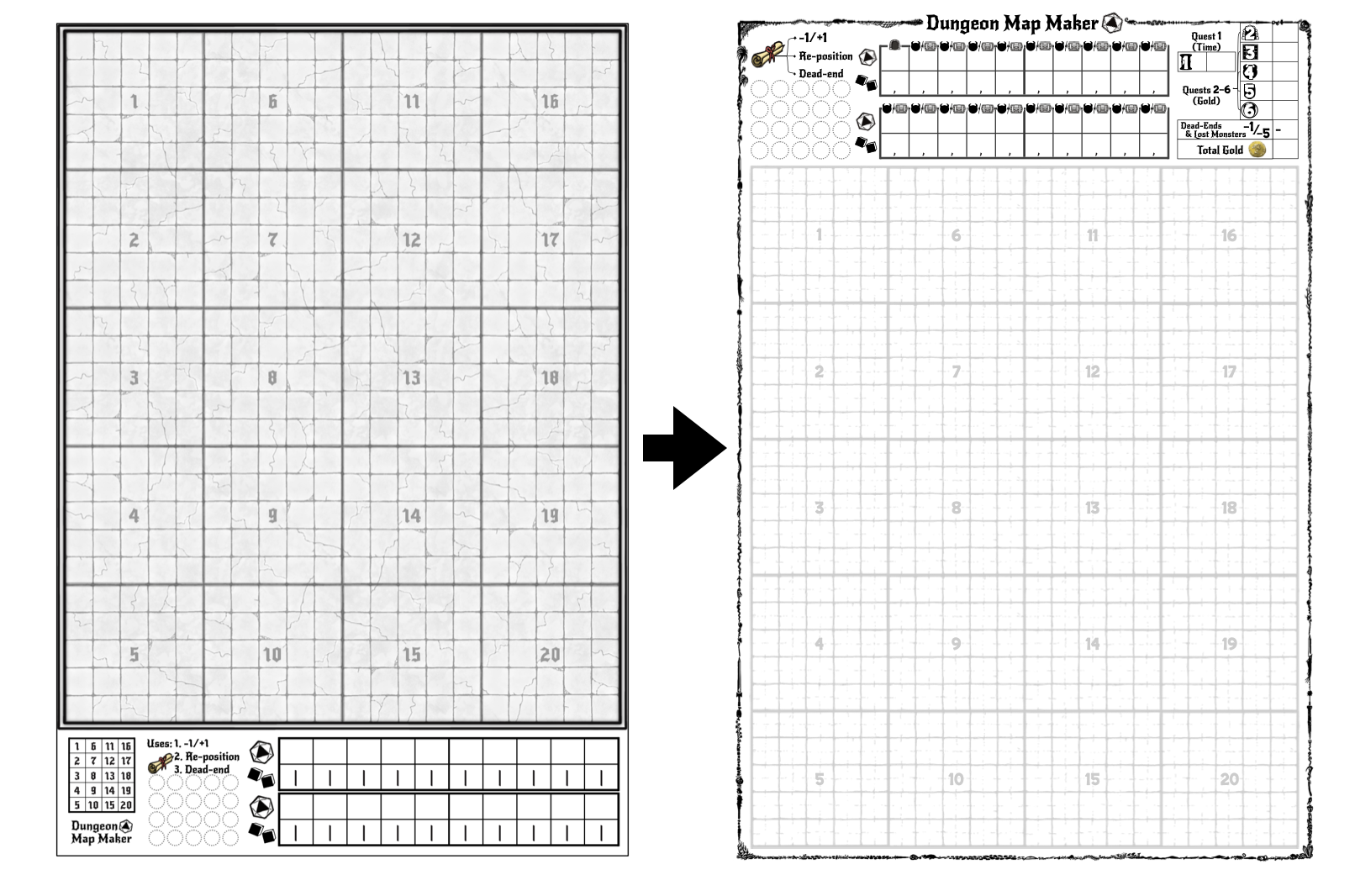
Exploration Phase Updates
The Exploration Phase went through many iterations before arriving at what I hope is a good balance of simplicity, luck, variety, and player agency. The goal was never to create a complex or deeply tactical dungeon crawling experience, but a streamlined adventure with the same duration and complexity as the Mapping Phase.
After all, it would be strange to play the mapping phase, which is a weight of about 2 on BoardGameGeek's complexity scale and takes about 30 minutes, then suddenly you are playing Mage Knight. (Besides, I don't have the skill or patience to design a game as complex as Mage Knight!)
In the end, 10 pages of the rulebook are devoted to the Mapping Phase: 14, the Exploration Phase; so I think they're close enough to one another in terms of rules complexity.
The way the Exploration Phase evolved during development can be seen by looking at the differences between an initial prototype card and one from the final version.
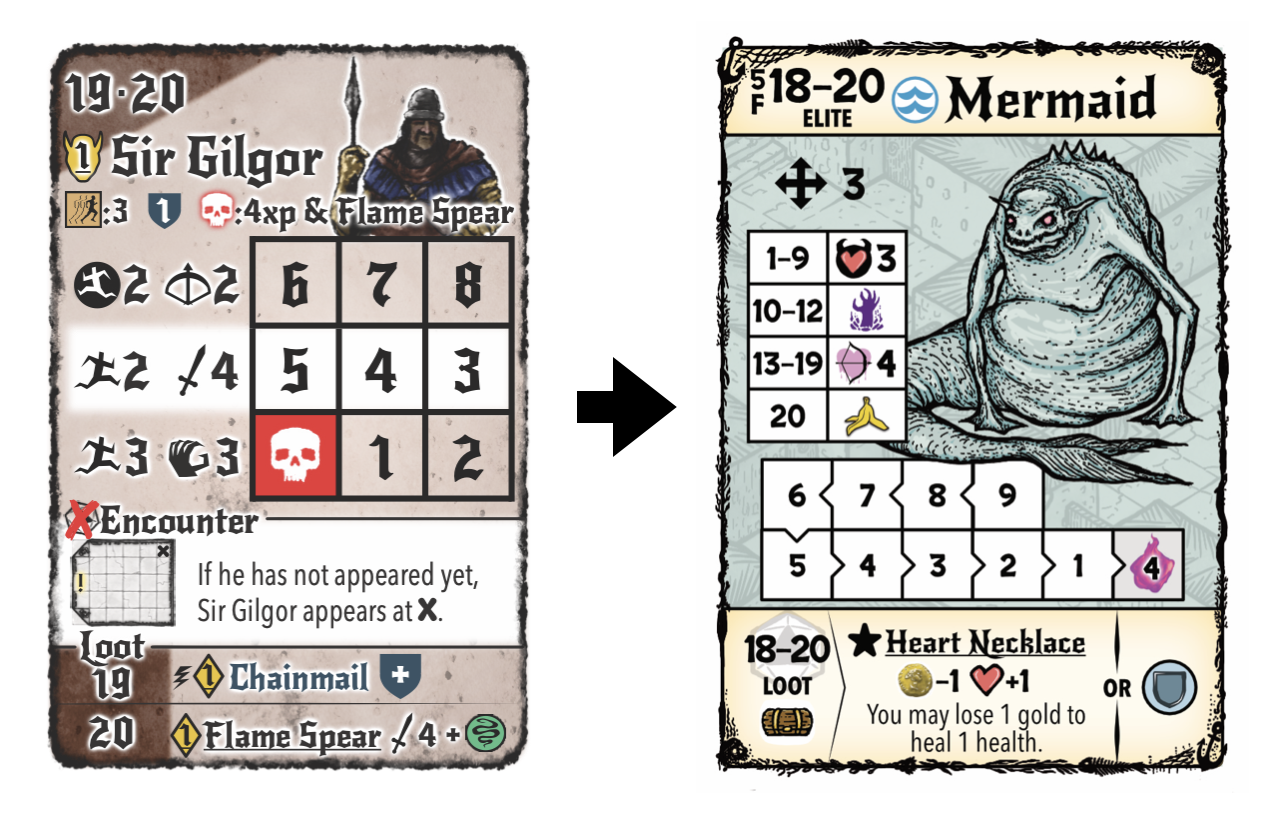
Some of the changes include:
- Creating more unpredictable enemy behaviour by tying the monsters' actions to a D20 roll rather than their health. This has the additional UX benefit of the player rolling all 3 dice at the start of each turn, which matches the turn structure of the mapping phase.
- Streamlining the card elements by removing the "Encounter" mechanic from the game entirely, re-doing the "Search" action, and having the perk gained from defeating monsters being the "Essence" resource.
- Making the print-and-play build process easier by including the card number in the upper left corner (5F in the example above).
- Simplifying the available Loot tied to each card by offering one unique item and one lesser item if the unique one has already been collected. Note: the Loot tied to each Monster card is independent of the monster.
- Overall layout improvement to better emphasize the hierarchy of the movement cost and allow more space for the monster image.
- Replacing the more "painterly" art style with inky line work to print better in black and white.
In addition, the Character Sheet that you take into the Exploration Phase is almost unrecognisable when compared to earlier versions:
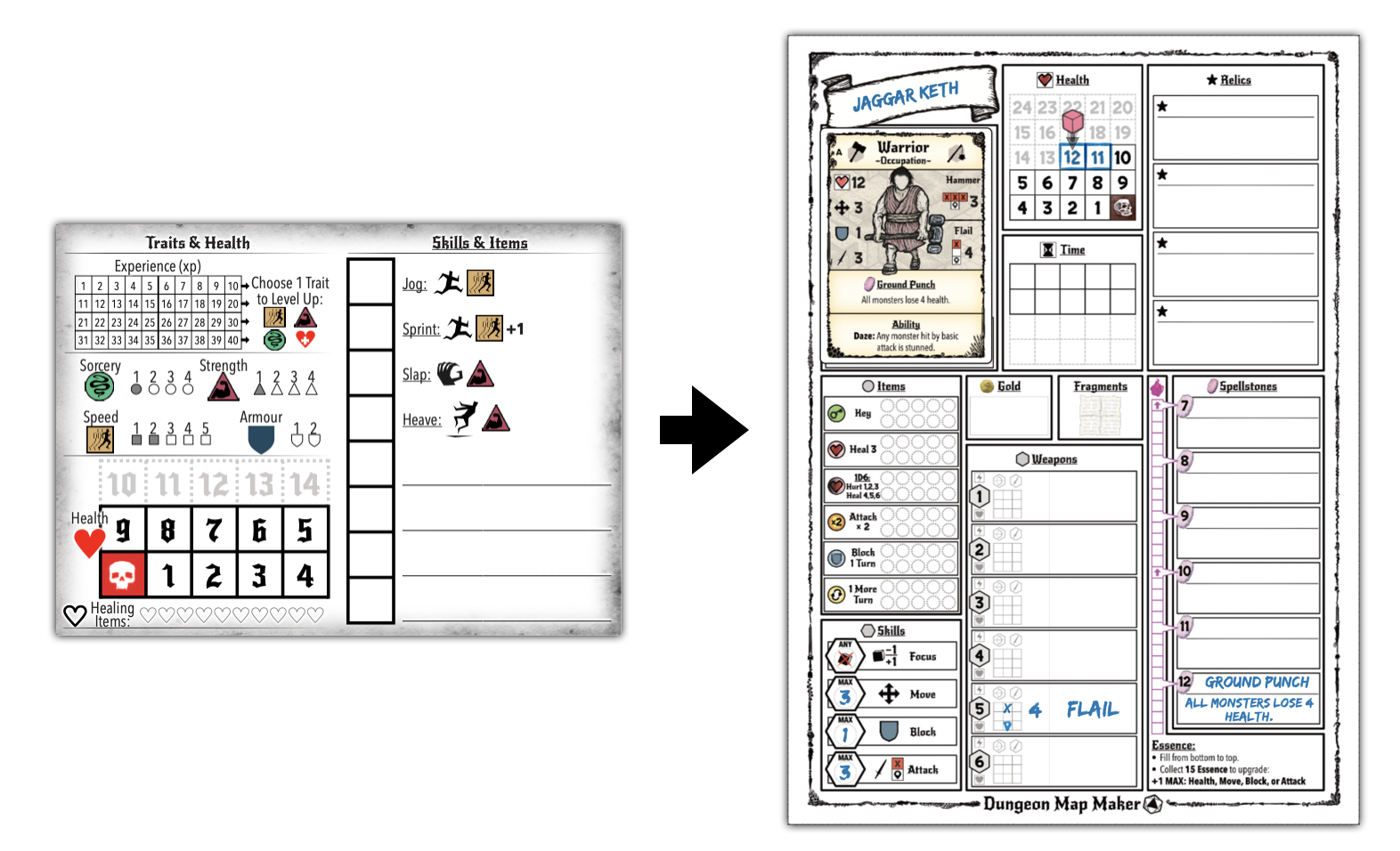
I'll admit that the final version of the Character Sheet looks like a bit of a mess at first glance, but I hope that its layout helps players by limiting the amount of writing and upkeep, while keeping things in as logical order as possible.
What's Next?
I have been saying the "final version", but there is still work to do on the game. By the end of the year, I hope to have the French, German, and Spanish versions finished, along with a small campaign that creates a loose narrative to a series of dungeon scenarios. Beyond that, I also hope to continue to make tweaks based on player feedback.
Despite the amount of rambling above, there are many things about the game I haven't covered. Feel free to leave any comments or questions if you have them.
Thanks for reading!
Harry
Files
Get Dungeon Map Maker
Dungeon Map Maker
Draw your dungeon, crawl your dungeon...
| Status | Released |
| Category | Physical game |
| Author | Harry Metcalf |
| Genre | Adventure |
| Tags | Dice, Drawing, Dungeon Crawler, Fantasy, mapmaking, No AI, Print & Play, Solo RPG, Tabletop |
More posts
- Dungeon Map Maker Update Notes (v.091)Jan 08, 2025
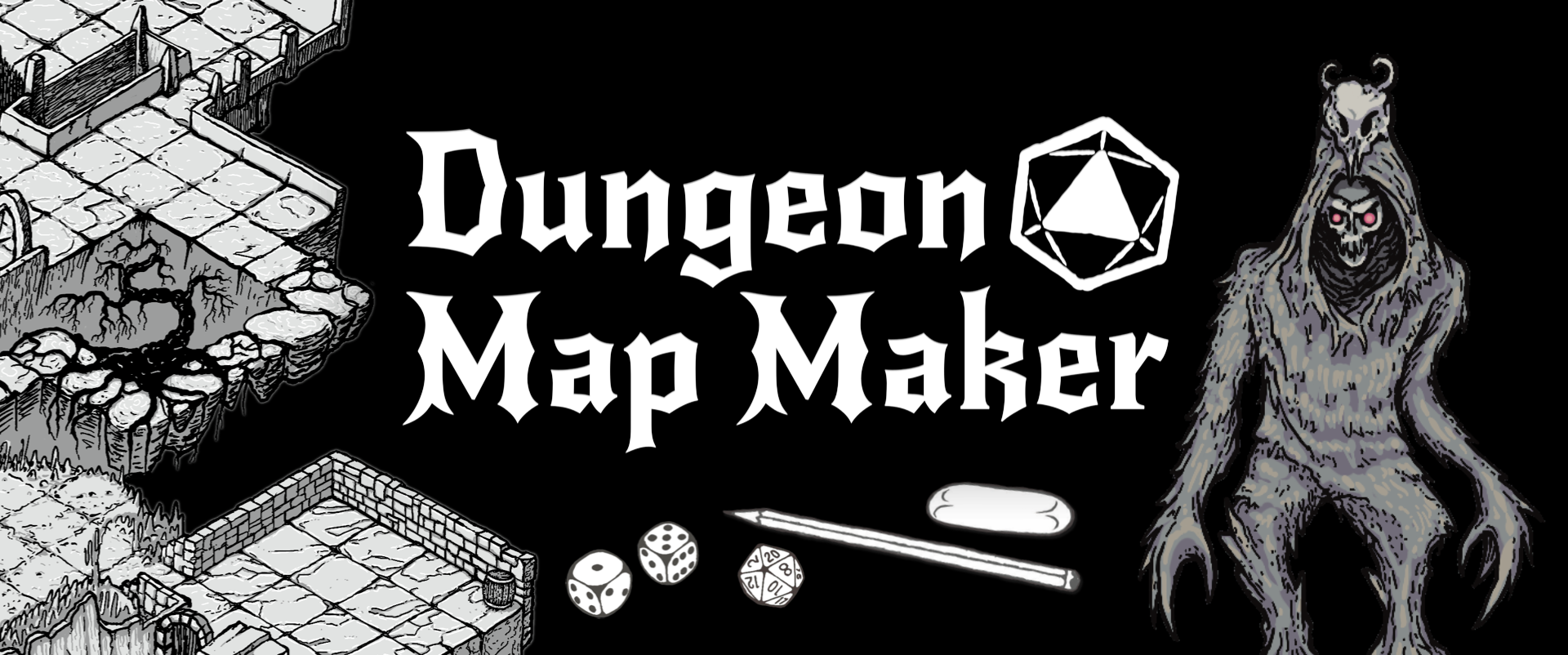
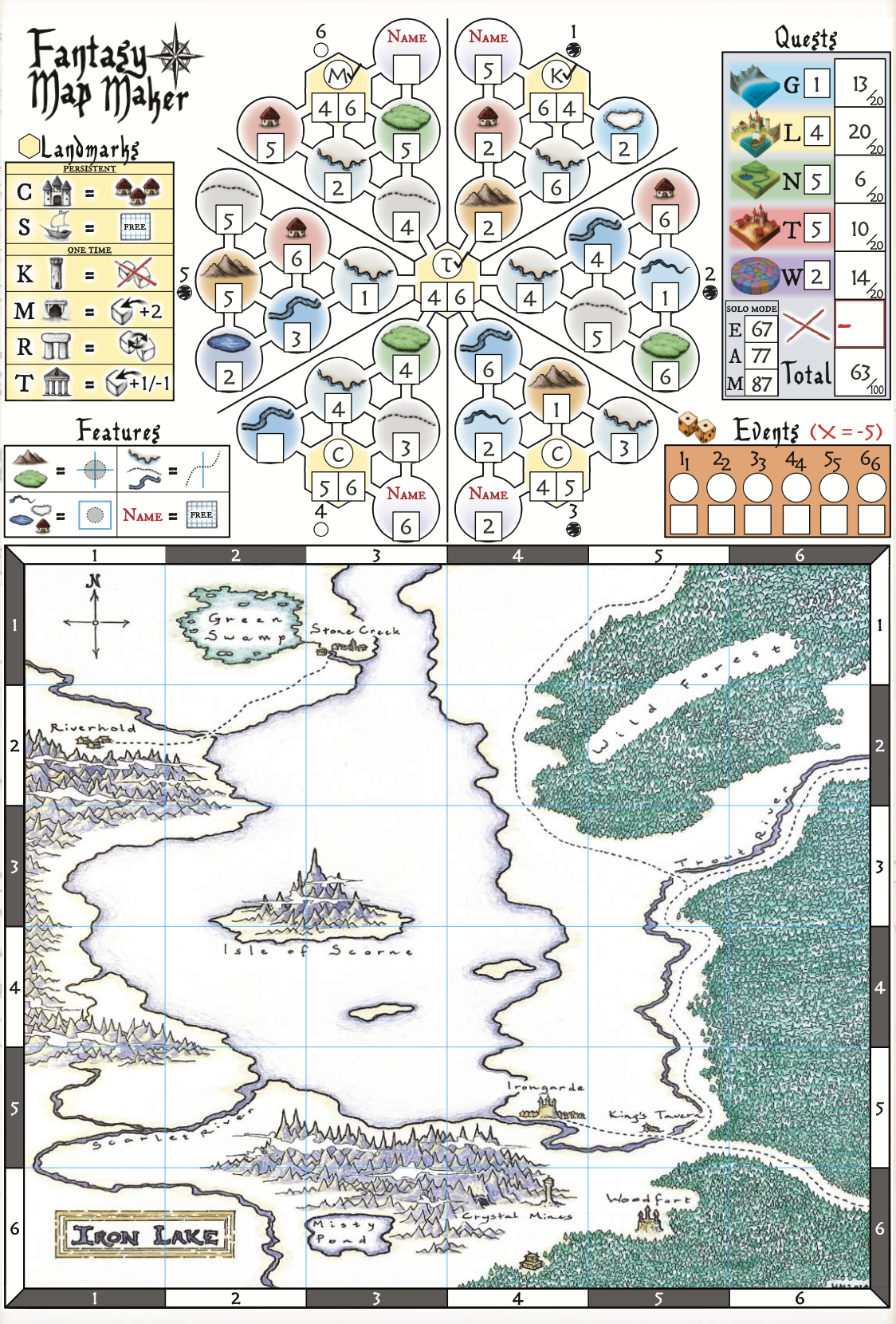
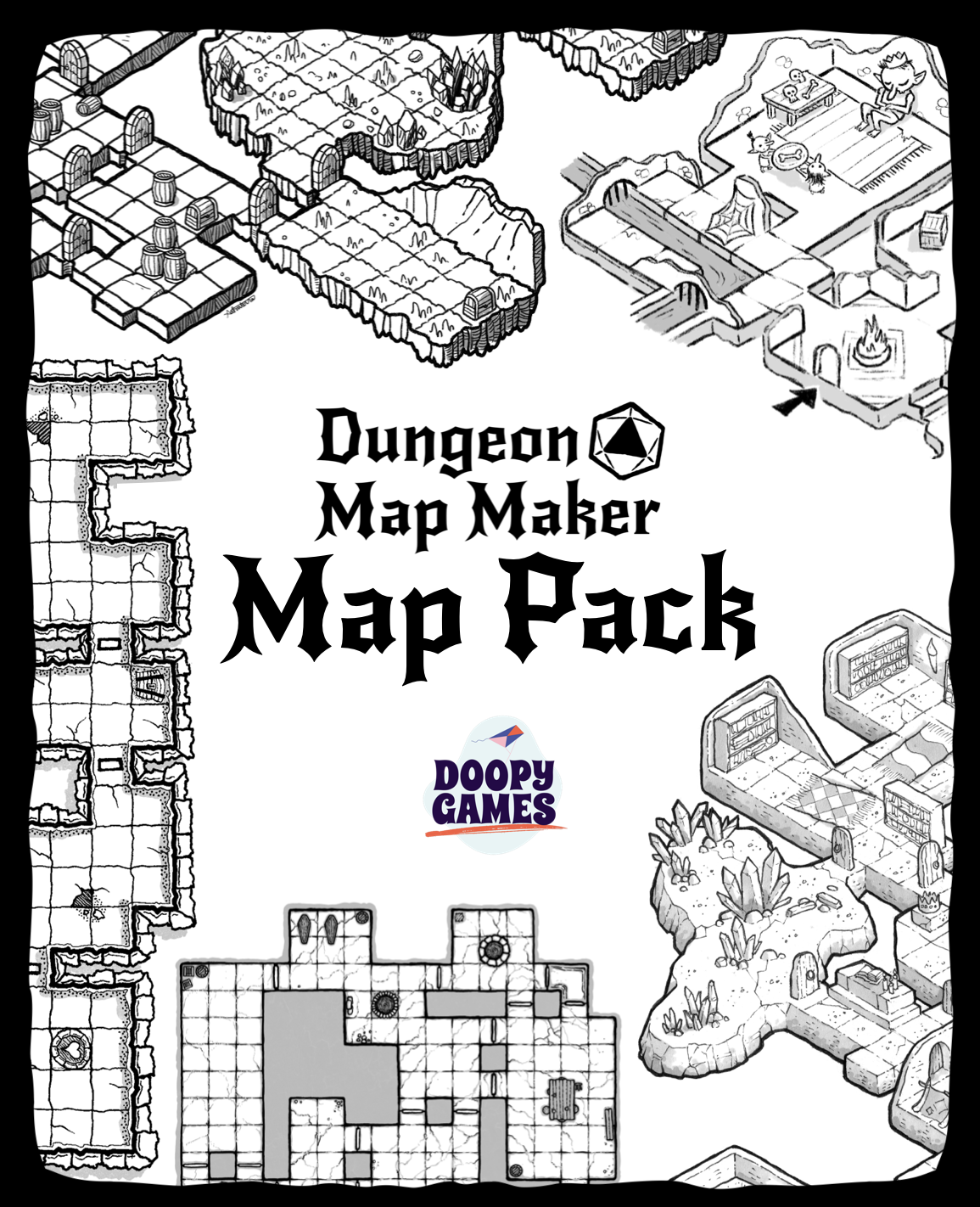
Leave a comment
Log in with itch.io to leave a comment.